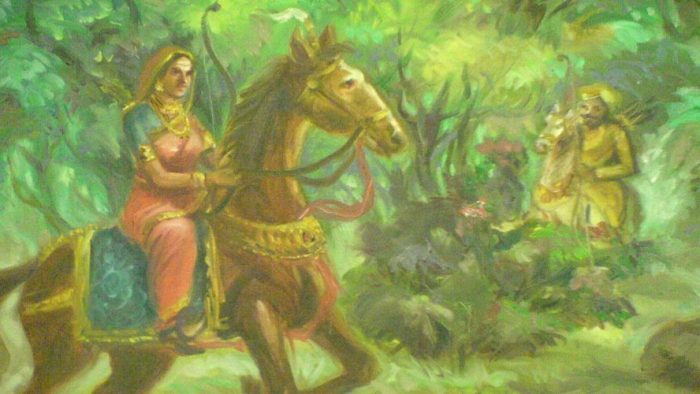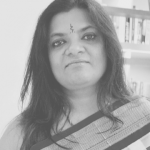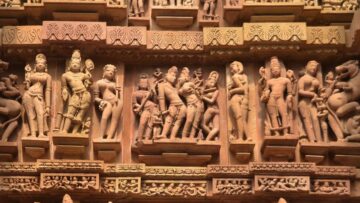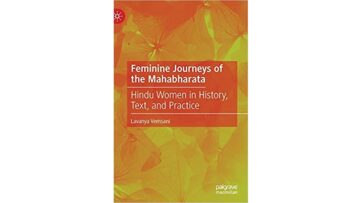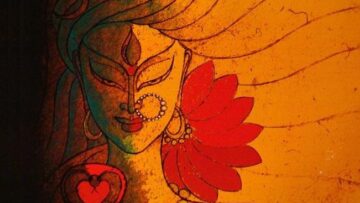It is that time of the year again, the 8th of March, when we focus our collective lenses on the woman question. There are articles and discussions on the problems we face and suggestions about the way forward.
In the Indian context it will also mean strings of “learned” articles on how the Indic/Hindu traditions regarding women must be abandoned if society is to move forward and women to achieve their potential. Leave the past behind, these learned intellectuals (or ignorant film actors as the case may be), will say, adopt the “feminist” point of view and the future will be in safe hands. The Marxist-Feminist viewpoint is deemed to be even more useful in the forward march of the female gender.
In these approaches and definitions there is absolutely no space for an Indic perspective.
Feminism began as a movement in 19th century Europe rooted in the egregious laws loaded against women put in place by the Church and the State in the Western world. Christian women demanded to be recognized as individuals and not chattel; they wanted property rights, voting rights, education and better working conditions. This first wave was rooted in a specific European historical, religious and social context.
This movement spread in the Western world and the second wave, between the 60s and the 80s of the 20th century concentrated on politics, culture, power differentials and the domestic sphere. Simone de Beauvoir, Betty Friedan, Gloria Steinem, Germaine Greer, Dorothy Smith etc. left none of these spheres unexplored and upended many traditional ways of viewing them.
In the 90s it slowly became clear that this feminism was the feminism of the elite, of White Christian Western women, their concerns and their issues. By then, of course, as a movement it had spread across the world including in India. The epicentre, however remained in the hands of White western women. With this realisation came the feminism of women of colour, of Islamic women of many other hitherto marginalised women. This was the Third wave.
Feminism is of many types; Liberal, Marxist, Radical and various melanges of these. From the liberals who think of feminism as a system of social and cultural inequalities to the Marxists who think of it in terms of power relations between women and men and the Radical feminists who think men are at the root of every problem in society there is a wide variation of opinions expressed.
Feminism has many strands but all of these put women at the centre of enquiry. It is a blow against androcentrism; it posits that women experience subordination on the basis of their sex and works to mitigate against this problem.
Where does the Indic understanding come in here? As can be seen from this brief introduction, the short answer is; nowhere.
As a method for putting women at the centre Indic ideas should be equally applicable to their own universe which has many women and many issues and problems to be solved. How can it be that a millennia old civilisation cannot offer any perspectives on this point of view?
Feminists will riposte that there is a civilisational religious bias against women especially in the Hindu tradition and a correct perspective lies precisely in belittling, negating and ultimately rejecting Indic ideas (This goes by the name of Marxist Feminist analysis). Hindu traditions are those of “Brahminical Patriarchy” and must be obliterated. Marxist Feminists like Uma Chakravarti lead a whole class of feminists who work with Indian data and have “established” the subordinate and humiliating position of women in early India and, of course, also in later times.
In what follows I will point out the problems in this approach and attempt to set out an Indic approach to the woman question, both theoretically and with illustrations from texts and history. The western civilisational paradigm has reached an effete end; the planet is being slowly destroyed under the onslaught of its aggressive, exploitative and greedy underpinning; we cannot look to it to provide answers for the future as it has nothing new to offer. We have to go forward with a re-look at the Indic tradition which may offer insights to not only Indian but universal issues.
Rejection of the Marxist-Feminist Myth of Subordinated Women of Early India
Marxist theory is Conflict Theory, to put it in sociological terms. It predicates its very understanding on dialectics, conflict and its resolution into a theoretical utopia of that apogee of human civilisation , a Communist system of society.
It is no surprise, therefore, that for Marxist Feminists the only possible relations between women and men are based on conflict. Men have more power, dominate and therefore humiliate and subordinate women in this class war. This is transposed onto India as the “superior” class of Brahmins engaged in exploiting and grinding women into the dust through the family system of “patriarchy”. The rest of the sordid India story follows from there. All of it is brought home to regressive Hindu texts (The other Indic religions escape somewhat as they are deemed to be attempts to “reform” Sanatan Dharma”) in both theory and practice.
This approach suffers from problems both of methodology and evidence which are very briefly outlined below.
Methodology: The origins and meaning of words imported from Greek via Latin (patriarchy) or other European languages are grafted onto an Indic reality with no regard for distortions. The same is true of the theoretical concepts which have sprung from Europe reality of the 19th century or USA of the Slavery period. For instance, the application of White vs African Slaves paradigm to caste relations with a parallel of Brahmin vs Other Castes is merely ludicrous. It has all the weight of a universally accepted theoretical construct in Liberal, Marxist circles, though. Again, well understood concepts are redefined in case they do not offer the pre-determined conclusions about women. (Read Uma Chakravarti’s remarks on the understanding of the concept of “Status”)
Evidence: The less said about this the better. There is an appalling lack of familiarity with the works referred to or quoted, possibly because most of these theorists know only English. Drawing evidence from Sanskrit, Tamil, Telugu, Ahomiya or folk traditions is a blinkered process as they do not know these languages /traditions and have to rely on translations. These are, again, mostly by equally ignorant experts who often have vested interests in denigrating Indic traditions. There is a tiny number of favourite texts (the overwhelmingly and wrongly quoted and contextualised Manusmriti for e.g.) and a vast corpus lies unexplored. Cherry picking of quotes from the works cited is another ploy. Positive historical examples are ignored for a repetition of some favourite negative examples interpreted in the most startling and outrageous, even false , fashion. (Take the perennial example of Shri Ram and Devi Seeta or the current trope that Holika was a Dalit woman and therefore exploited in the story of the casteist , sexist festival of Holi.)
An Indic Approach
At this juncture , apart from critiquing and exposing the old paradigms in the understanding of women of India we must also offer an alternative approach and structure and carry this forward.
Taking into the account the stunning diversity of Indic traditions I propose to follow the idea at the root of the concept which titles this article: ऊर्ध्वमूलमधःशाखमश्वत्थं.
This is part of a shloka from the 15th chapter of the Bhagawat Geeta and the 6th chapter of the Kathopanishad, the oldest part of the Vedic-Upanishadic corpus. It refers to the imagery of a Ashwatha tree with its roots growing upwards and the branches down in the world. This is the ब्रह्म वृक्ष, the world tree, with the creator and the created part of it. The roots are ब्रह्म or Parmeshwar and the spread of branches and trees on earth are what we understand as the world, प्रकृति ( in terms of Sankhya) or माया in terms of Vedantins.
To adopt and adapt it for our purposes think of the roots as Indic traditions for women and the branches and leaves as the reality we have to grapple with every day. This is an infinite world tree and has branches and leaves of all kinds. We need to trace these to the root and, if necessary prune and cut off the trees and branches which have rotted away and are no longer relevant.
How do we envisage this root and understand it? Only the briefest of outlines can be given in an article of this scope.
Through a new and properly focused study of works in Indic languages in the original versions (especially Sanskrit) one must arrive at a fresh and clear understanding of what was posited in these works about women. Then, evidence from history, archaeology , numismatics epigraphy, other interdisciplinary subjects must be compared with theoretical approaches to come to some more valid conclusions about Indic women. These will be more valid simply because they will be evidence and not ideology and opinion based. Also this will be an emic rather than imposed and artificial understanding.
As one engaged in this endeavour, here are my preliminary ideas.
Ancient Indian society was based on a few basic precepts revolving around Varnashrama Dharma and the four Purusharthas of Dharma, Artha, Kama and Moksha.
Since caste is one of those short cut acid attacks on the face of Hinduism which are very popular amongst those oppose and dislike it, a longer exposition will have to be given on its treatment for which I do not have space here. Suffice it to say that I take it as a metaphor for the occupation an individual wishes to follow.
Commonly, the Ashrama system is understood as four chronological phases of the ideal life where studentship is followed by the life of a householder then a forest hermit and then a sanyasi or ascetic. Following Maharshi Gautam (one of the formulators of the system) and some others, however, it has an alternate meaning. He calls it a vikalpa or a choice made between these four alternate and equally valid ways of life, made at the time when a young adult finishes Vedic studentship and becomes a snaatak.
The four purusharthas framework is for understanding the deepest aspirations of life as lived on earth which may be for leading an ethical life or a rich life or one which fulfils all material desires or in the end, transcends all of them.
This varnashrama and purushartha based framework includes therefore all aspects of individual women’s lives that are the subject of our study.
The way forward: Using the Indic Framework
If this framework is used to analyse the position of women it will have the advantage of using those categories which Indics themselves used to think about the life of the individual and his or her place in society. I must add here that it brings into central focus the much-repeated untruth that women had no access to education in ancient times. (In fact it is in modern colonial and post colonial times that the indigenous system of education was destroyed and most non elite sections of society including women and Dalits found educational opportunities decreasing.)
In trying to understand the lives and choices of women a start can be made by looking at how they chose to lead their lives.
A question of the availability of this choice to women may be raised. A study of the commentaries on Maharshi Yagyavalkya and the sutras of Maharshi Baudhayana as well as certain interpretations of Maharshi Manu indicate that celibacy and asceticism were as well available to women as to men. Although, as a matter of practice the large majority of women ( and men ) chose Grihastha Ashram after finishing their education.
On applying this framework to actual praxis (as Marx would say) there is ample historical evidence of women following different occupations and choosing different ashramas throughout Indian history. From Queens and councillors to intellectuals and rishis to artists and dancers, temple builders and devotees , free thinkers and economic agents, mothers and wives there is no aspect of society where Indic women did not or were not allowed to contribute.
This is the root we must never lose sight of. It manifests itself in the Indic tradition of philosophy and theology, its theory and practice.
Take the Sri Suktam for example. The Purush Sukta from the Rig Veda has been analysed to death for its alleged casteist implications. How has the Sri Suktam been ignored inspite of its feminist implications? It is perhaps the oldest original manifestation of the Indic thinking on women but is completely missing from the discourse. Thinking of the ancients on every aspect of a woman’s life can be drawn from it but this has not been done.
Such examples are aplenty and build up to a pattern, a pattern of pre decided denigration of the Indic tradition of women by ignoring all that does not fit into this pattern.
This has to be opposed with reasoned analysis and evidence, reiterated until centuries of misinformation is erased. New role models will have to be raised up and popularised.
We must be inspired today by the wisdom of Lopamudra, Sulabha and Gargi, the poetry of Vijjika or Avantisundari, the mathematics taught to Leelavati, the spiritualism of the Avaiyars and Sree Andal, the valour of Kaikeyi or Chitrangada, Rani Laxmibai, the piety and courage of Ahilyabai Holkar, the resolution of Seeta and Savitri, the political acumen of Didda and Rudramadevi, the honour of Kannagi and Padmini and the strength of Draupadi to fight adversity.
We must go on making our point and offering evidence with clarity and persistence because it will not be easy to be heard in all this noise.
The dust of centuries and the mist of misfortunes such as invasion and colonisation have to be wiped off so that we can see our roots with dazzling clarity and accordingly reshape our विश्ववृक्ष, the world tree, as it was meant to be.
Disclaimer: The opinions expressed in this article belong to the author. Indic Today is neither responsible nor liable for the accuracy, completeness, suitability, or validity of any information in the article.

